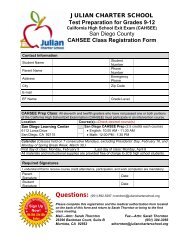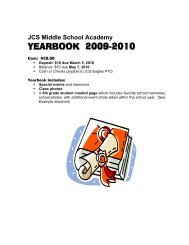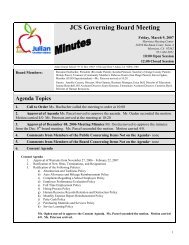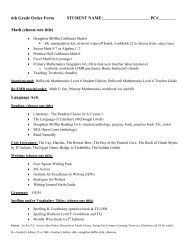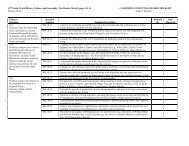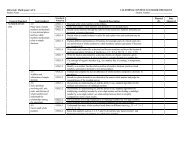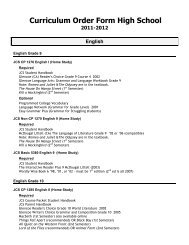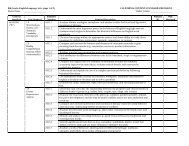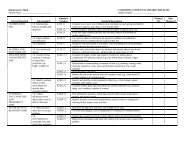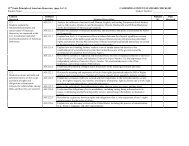2009-2010 Self-Study WASC Action Plan - Julian Charter School
2009-2010 Self-Study WASC Action Plan - Julian Charter School
2009-2010 Self-Study WASC Action Plan - Julian Charter School
You also want an ePaper? Increase the reach of your titles
YUMPU automatically turns print PDFs into web optimized ePapers that Google loves.
Findings<br />
B2. To what extent do all students have access to the<br />
school’s program and assistance with a personal<br />
learning plan to prepare them for the pursuit of their<br />
academic, personal and school-to-career goals?<br />
SUMMARY<br />
• Students’ four-year plans note future goals, chart progress<br />
in meeting requirements for graduation and/or college<br />
entrance, and guide course selection and sequence.<br />
• Learning plans are viewed as flexible blueprints and are<br />
revised and updated as needed; counselors review all fouryear<br />
plans annually (at a minimum).<br />
• Staff and academic counselors (one home study/one 6-12<br />
academies) consult with students and families and discuss<br />
the connections between courses, future options, and<br />
academic performance with students.<br />
• Students have avenues to explore personal/career interests.<br />
PERSONAL L EARNING PLAN— A CADEMIC A CHIEVEMENT<br />
• All students have personalized learning plans that are<br />
used as a basis for course selection, curriculum level,<br />
program choices, and exploration of future options.<br />
• K-8 home school families collaborate with staff at<br />
least every 20 days to discuss curriculum and<br />
instruction with frequent phone calls and e-mails<br />
in-between meetings.<br />
• Academy families meet on an ongoing basis with<br />
staff to discuss individual learning plans (K-8) and<br />
four-year plans (9-12), and meet at least quarterly<br />
to discuss student progress.<br />
• High school students develop a four-year plan with<br />
parents and staff. All four-year plans are reviewed<br />
by an academic counselor.<br />
• Implications of/sequence for math courses is carefully<br />
explained to facilitators, advisors and coordinators<br />
to guide middle school math placement.<br />
• Parents and students help develop IEPs with<br />
special education staff via IEP meetings.<br />
• Additional resources are available for parents to<br />
collaborate/develop as parent-teachers: monthly<br />
seminars (K-8 ACs), Meet and Greet meetings,<br />
Curriculum Expo, parent support groups, and<br />
parent advisory groups.<br />
Evidence<br />
• Goal sheets<br />
• 9-12 four-year plans<br />
• K-8 academy individual<br />
leaning plans (ILPs)<br />
• Master agreements<br />
• Flyers/e-mails<br />
• IEPs<br />
• Graduation rate<br />
• Parent/student interviews<br />
• INSITE program<br />
Chapter 4: <strong>Self</strong>-<strong>Study</strong> Findings: Curriculum<br />
64 <strong>Julian</strong> <strong>Charter</strong> <strong>School</strong> Focus on Learning <strong>2009</strong>-<strong>2010</strong>



